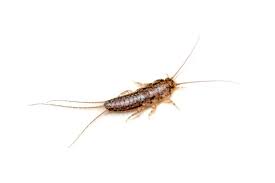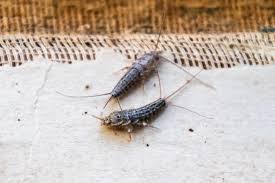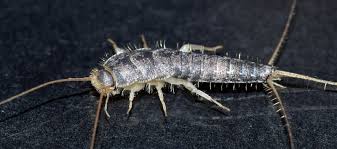Silverfish Life Cycle
Life Cycle Stages
The silverfish process from egg to adult
usually takes about four months. They are hemimetabolis insects, which means
they develop through three stages:
Reproduction
While silverfish do not reproduce through
direct fertilization of the eggs, they do perform a mating dance.
- The
insects touch their antennae together.
- The
female flees.
- The male
and female reunite. They stand side by side while the male vibrates his
tail.
- Males
then deposit small packets of sperm into the female ovipositors.
Eggs
Depending upon climate conditions and
species, eggs may take between 19 to 60 days to hatch. Humid conditions are
preferable, though silverfish can thrive in almost any environment.
Female silverfish produce one to three eggs
per day, or clusters of two to twenty. The pests deposit eggs in cracks around
the inside of a home or attic, making them difficult to find. Unlike some other
insects, silverfish can produce eggs all year.
Nymph
When they emerge from the egg, silverfish
nymphs are miniature versions of the adults. They go through a number of molts
during development, and continue to molt throughout their lives. Some species
may undergo more than 50 molts.
Adults
Typically, silverfish become adults in
about three or four months. In cool climates, it may take up to two years to
develop into a mature adult.
Encounters & Concerns
The surrounding environment has a major
influence on silverfish development and how long silverfish live. In ideal environments
of high temperatures and humidly, these insects can live for about three years.

What do silverfish look like?
Silverfish range from 1/4” to 1” in length.
Their bodies consist of a head, abdomen, six legs, two compound eyes, two long
antennae, and three appendages that resemble tails. The body of the silverfish
is flat and narrow and tapers down from the head in the shape of a carrot. It
is covered in shiny, silver-grey scales. Two of the tail-like appendages,
called cerci, point to the sides of the body, with the filament (or middle
appendage) between them pointing backward. Silverfish do not have wings; they
move by using their legs in a wiggling motion that resembles a swimming fish.
Silverfish can run quickly on horizontal surfaces but are not as fast when
moving vertically. However, they are able to jump up to a foot in the air.
Silverfish grow from egg to nymph to adult.
The female lays up to three white, oval-shaped eggs in a crack or crevice. When
the eggs hatch — which can vary from a period of three to six weeks depending
on temperature — pale nymphs emerge. These nymphs continue to grow into
adulthood, molting as they do and developing scales that are dark, shiny, and
silver-colored. The normal lifespan of a
silverfish is between two and eight years. Silverfish reproduce at all times of
the year, with the female laying about 100 eggs over the course of her
lifetime.
What are the risks of a silverfish
infestation?
Because they are adept at hiding,
silverfish can grow in numbers before being discovered, resulting in a
significant infestation. These pests do not bite or directly cause harm to
humans or pets, but they are destructive to your home. Silverfish can
contaminate foods and eat through fabrics, paper, or other items.
Silverfish eat mold, so their presence may
also indicate a mold issue in your home. They are also a preferred food of
spiders, centipedes, and other insects, so silverfish in your home may attract
these pests.

When are They Active?
You and the silverfish likely have very
different schedules, so you may not run into them too frequently unless you
wake up in the middle of the night.
A common silverfish encounter usually
occurs when someone walks into their bathroom at night and turns on their light
to find a silverfish in their bathtub. This is somewhat of a prison for
silverfish because they struggle to climb out of bathtubs due to their lack of
extra appendages. They are poor climbers, but exceptional runners.
Silverfish are very quick, and can outrun
the majority of their predators. Seeing a silverfish run in your home is a very
unsettling sight that is sure to send shivers up your spine.
They will often scurry off into dark and
secluded places. Silverfish are nocturnal, so they prefer to stay hidden during
the brighter hours of the day, and will likely only come out when your lights
are off.
The perfect conditions for silverfish are
dark environments with temperatures around 70 to 90 degrees Fahrenheit,
although they can survive in temperatures above 50 degrees.
Silverfish thrive in moist conditions, so
they are often found in parts of your home that may be harboring excess
moisture. They are often found in bathrooms, kitchens, laundry rooms, garages,
cabinets, or near leaks.

Sign of a Silverfish Infestation
Keep an eye out for feeding marks, although
they may be irregular whether they are holes, notches along an edge, or surface
etchings. Yellow stains, scales and/or feces (tiny black pepper-like pellets)
may also be seen on infested materials.
These pests can typically be found in
humid, moist areas of the home including basements, attics and bathrooms.
People have noticed silverfish when they come down on ceiling soffits and/or
drop from skylights and canister light fixtures in the ceiling, likely entering
through shake roofs.
What is the Best Way to Kill Silverfish?
There are numerous ways to kill silverfish,
including the use of boric acid and diatomaceous earth. Silverfish can be
captured and killed using glasses wrapped in masking tape and filled with sugar
water as bait. Another way to get rid of silverfish is to spray a mixture of
bleach and water in the areas where they live or points where they access a
home. The best way to control silverfish is to make one’s home inhospitable to
these insects.
Boric acid is an effective means of
silverfish extermination, though it’s a low-grade toxin. Children and pets must
be kept away from areas in which boric acid is used. The powder should be
sprinkled where silverfish have been noticed. Particular attention should be
paid to areas where silverfish like to hide, such as under sinks and in cracks
and crevices. More boric acid can be sprinkled every two weeks as needed to
kill silverfish.